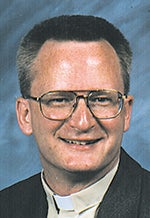Across the Pastor’s Desk: Find a new life within the heart
Published 8:00 pm Friday, April 21, 2023
|
Getting your Trinity Audio player ready...
|
Across the Pastor’s Desk by Todd Walsh
The Church of the Holy Sepulcher in Jerusalem marks the site of the death and resurrection of Jesus. The original building dates from just 300 years after the dying and rising of Jesus. It has suffered damage and destruction by natural and human means, yet the structure remains and pilgrims still make the journey to within its walls.
The first thing you see on entry is the anointing stone. This is the place our Lord was prepared for burial. It is a large stone that has been replaced several times through the centuries as pilgrims wear it down by their touch. To the right and up just a few steps is the Calvary chapel. This is the remains of the place of crucifixion and some of the stones of the hill are still visible under glass.
Then beneath the dome of the church is the edicule, the “little house.” It is the tomb of Jesus, the site of his burial and resurrection. I had read about it quite a bit before I saw it in person. I knew it would be small. But it was not small.
This is a large structure. Then you go into the structure and its two chambers. The first chamber is where the remains of the stone that sealed the tomb is preserved under glass. There’s not much left. And the second chamber is the tomb. There is room for three people to stand or kneel. And the burial platform is just that long.
But there is something amiss with this building. The inside is far too small for its outside dimensions. The walls are thick. Some historians said the walls contain the remains of the original limestone tomb. Others called that impossible.
But the three communities that exist within the church agreed to restore the edicule in 2016. They scanned the structure. They saw a third wall about six feet tall between the inside and outside marble walls. They opened some of the wall and found native limestone. Finally they removed the marble cover over the burial platform. They found a smooth but broken marble stone with a cross carved in its middle. Beneath it native limestone again appeared forming the burial platform. And radio-carbon dating of the marble slab with the cross landed in the fourth century — the time the church was built.
There is one more detail here, perhaps the most important. Beneath the tomb is a tunnel. It was carved even before even before the church built around Calvary. There is a carving at the end of the tunnel nearest the tomb: “Lord, we have come.”
Here was proof that even when belief in Jesus could cost your life the faithful sought to be near their Lord.
Those who dug that tunnel looked within. The women at the empty tomb and the disciples who followed also looked within. At first their look within was physical, then it became spiritual. They knew their Lord had risen. They knew he was alive. They did see him and some ate with him. And even after he ascended into heaven they knew he was still alive.
And not just alive in heaven. He was alive within them in their hearts. He spoke to their hearts through his word we now know as the Bible. He fed them through the meal we now call the sacrament of Holy Communion, and he touched them through the community that he gathered then and still gathers now.
We too are those who look within but we do not find limestone. We find the living stone that is the gift of faith to know our Lord. We too believe he is alive. We too believe he is among us. And we too seek his word and live to live the way he shows us each day.
So call on his name because not only is he risen but he is also near. Take in his word and find new life for each day. Gather as his disciples and be fed with food that fills and forgives and keeps us returning to our Lord all of our days. Look within. He is alive among us and within us.
Todd Walsh is director of spiritual care services at Thorne Crest Senior Living Community in Albert Lea.


